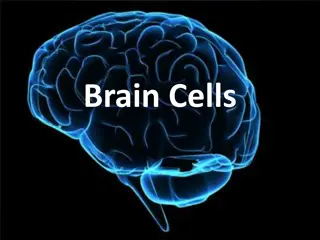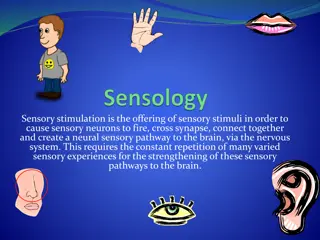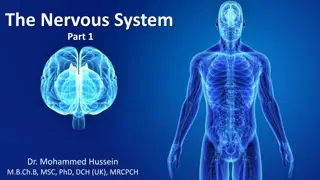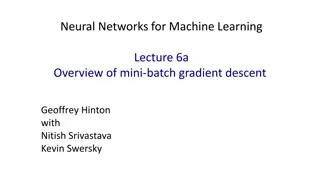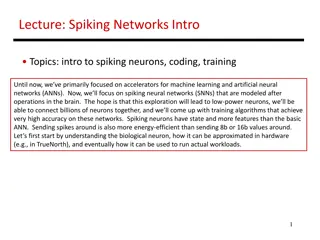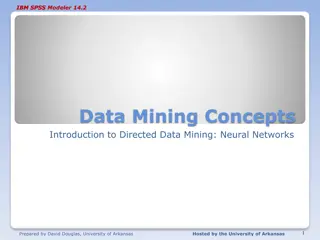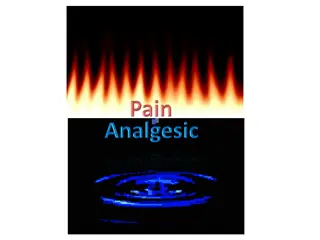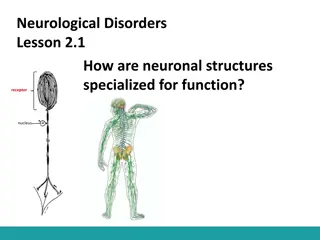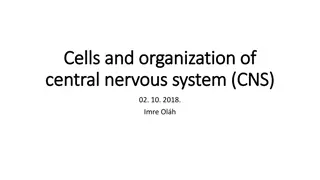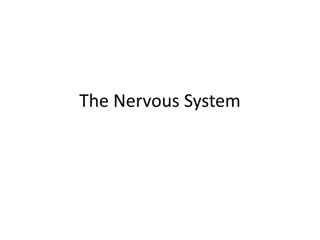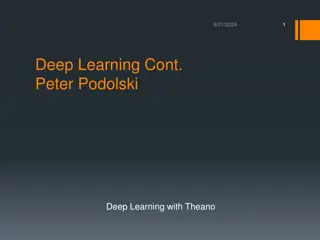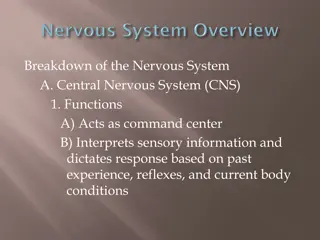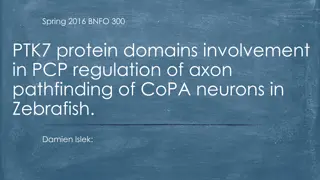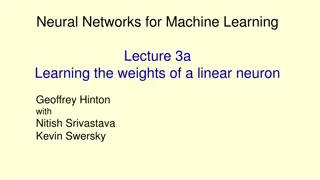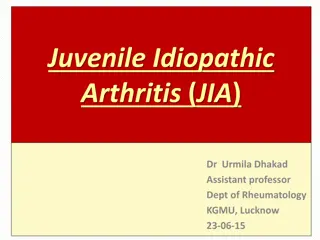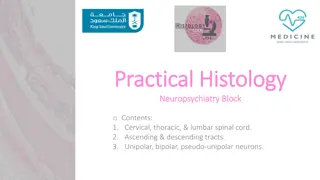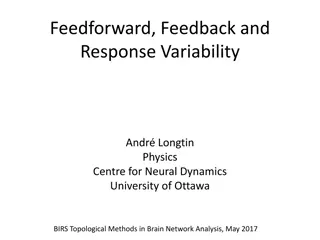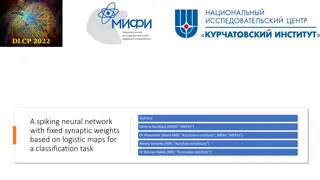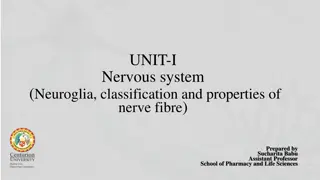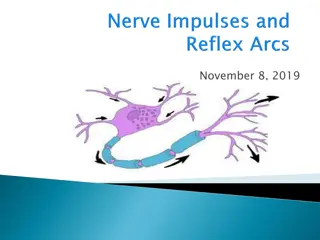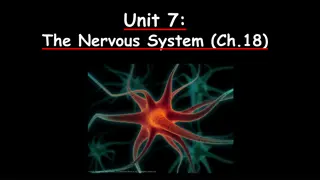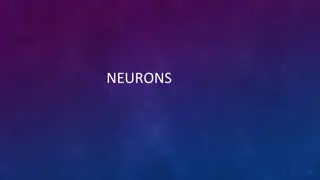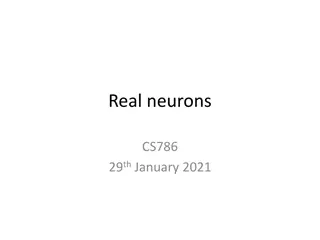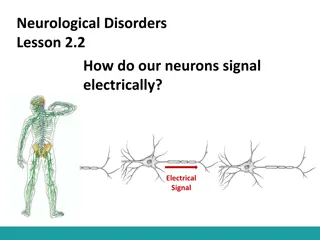Introduction to Deep Learning: Neural Networks and Multilayer Perceptrons
Explore the fundamentals of neural networks, including artificial neurons and activation functions, in the context of deep learning. Learn about multilayer perceptrons and their role in forming decision regions for classification tasks. Understand forward propagation and backpropagation as essential
3 views • 74 slides
Brain Cells
Delve into the fascinating world of brain cells and neurons to understand their structure, function, and communication process. Explore the microscopic level composition of the brain, the significance of neuron shapes, and the intricate workings of synapses in transmitting signals between neurons. U
1 views • 14 slides
Current Issues with Contribution-Based Benefit Cap and Anti-Spiking Law
Delve into the current challenges surrounding the Contribution-Based Benefit Cap and Anti-Spiking Law, including concerns about pension calculations, vacation and sick leave impact, and the calculation of spiking amounts affecting highly paid employees.
3 views • 17 slides
Sensory Stimulation for Neural Pathway Development
Sensory stimulation involves offering sensory stimuli to activate sensory neurons, cross synapses, and create neural pathways to the brain. Consistent exposure to varied sensory experiences is crucial for strengthening these pathways. The provided content includes activities such as introducing lear
0 views • 9 slides
The Basics of the Nervous System with Dr. Mohammed Hussein
Explore the fundamentals of the nervous system in Part 1 with Dr. Mohammed Hussein, covering nerve cells, cellular processes, types of neurons, nerve structure, blood vessels, grey matter, and afferent and efferent neurons. Gain insights into the key components that make up this intricate system.
0 views • 12 slides
Network Compression Techniques: Overview and Practical Issues
Various network compression techniques such as network pruning, knowledge distillation, and parameter quantization are discussed in this content. The importance of pruning redundant weights and neurons in over-parameterized networks is highlighted. Practical issues like weight pruning and neuron pru
2 views • 37 slides
Electromyography (EMG) and Motor Neurons
Electromyography (EMG) is an electrodiagnostic technique used to evaluate muscle health by measuring electrical activity. EMG measures muscle response to nerve signals, displayed as waves on an oscilloscope. Motor neurons transmit signals from the brain to muscles, enabling movement. Upper motor neu
2 views • 8 slides
Unlocking the Power of the Human Brain: Insights from 11th ICPAR Annual Training Conference
Delve into the intricacies of the human brain at the upcoming 11th ICPAR Annual Training Conference themed around "Brain Power to Embrace Change and Emotional Stability." Explore the control center of our minds, the cerebral cortex, the limbic system, and the role of neurons in conscious mental reac
0 views • 57 slides
Mini-Batch Gradient Descent in Neural Networks
In this lecture by Geoffrey Hinton, Nitish Srivastava, and Kevin Swersky, an overview of mini-batch gradient descent is provided. The discussion includes the error surfaces for linear neurons, convergence speed in quadratic bowls, challenges with learning rates, comparison with stochastic gradient d
0 views • 31 slides
Spiking Neurons and Spiking Neural Networks
Spiking neural networks (SNNs) are a new approach modeled after the brain's operations, aiming for low-power neurons, billions of connections, and high accuracy training algorithms. Spiking neurons have unique features and are more energy-efficient than traditional artificial neural networks. Explor
6 views • 23 slides
Cholinergic Neurons and Agonists in Pharmacology
Cholinergic neurons play a vital role in neurotransmission by utilizing acetylcholine (ACh) as a neurotransmitter. This neurotransmission involves steps like synthesis, storage in vesicles, release, receptor binding, degradation, and recycling of choline and acetate. Choline acetyltransferase cataly
0 views • 30 slides
Introduction to Neural Networks in IBM SPSS Modeler 14.2
This presentation provides an introduction to neural networks in IBM SPSS Modeler 14.2. It covers the concepts of directed data mining using neural networks, the structure of neural networks, terms associated with neural networks, and the process of inputs and outputs in neural network models. The d
2 views • 18 slides
The Nervous System and Sensory Neurons
The nervous system plays a crucial role in connecting the central nervous system (CNS) to limbs and organs through the peripheral nervous system (PNS). It consists of sensory neurons that transmit impulses from sensory receptors to the CNS, allowing us to perceive and respond to various stimuli. The
0 views • 23 slides
The Nervous System: A Comprehensive Overview
The nervous system consists of the central nervous system (CNS) and peripheral nervous system (PNS), with neurons as its basic unit. Neurons function as sensory, associative, and motor types, carrying impulses within the body. Parts of a neuron include the cell body, dendrites, axon, and terminal en
2 views • 86 slides
Neuronal Specialization and Functions
Explore how neuronal structures are specialized for functions, compare different types of neurons, learn about the functions of neurons, and delve into the processes of receiving, processing, and sending signals within neurons. Discover the unique features of axons and synapses, and understand how t
1 views • 16 slides
Overview of the Central Nervous System and Neurotransmitters
The human central nervous system (CNS) is composed of neurons that transmit information through electrical impulses and neurotransmitters at synaptic junctions. Synapses play a crucial role in interneuronal communication, with various types and features impacting information transmission. Neurotrans
0 views • 13 slides
The Nervous System: Structure and Function
The nervous system is a complex network divided into the central nervous system (CNS) and peripheral nervous system (PNS). Neuroglia, or supporting cells, play vital roles in maintaining the health and function of neurons. Neurons, the fundamental units of the nervous system, vary in structure and f
1 views • 29 slides
Introduction to Brian: A Simulator for Spiking Neural Networks
Brian is a simulator designed for spiking neural networks, focusing on ease of use, flexibility, performance, and reliability. It allows runtime code generation, C++ conversion, and GPU support for enhanced performance. Despite limitations in large-scale simulations, Brian is ideal for small network
0 views • 7 slides
Deep Learning with Theano: Installation, Neurons, and Exploration
Delve into the world of deep learning with Peter Podolski's comprehensive guide on utilizing Theano for neural network development. Explore topics such as installation on various systems, working with neurons, and unlocking the potential for CPU and GPU optimization. Discover insights on hidden node
0 views • 20 slides
Overview of the Nervous System Components and Functions
The nervous system is comprised of the central nervous system (CNS) and the peripheral nervous system (PNS). The CNS acts as the command center, interpreting sensory information and coordinating responses. The PNS conveys information to and from the CNS through somatic and visceral sensory neurons,
0 views • 48 slides
Regulation of Axon Pathfinding in Zebrafish CoPA Neurons by PTK7 Protein Domains
Understanding the involvement of PTK7 protein domains in the PCP pathway regulation of axon pathfinding in CoPA neurons of Zebrafish. The experiment aims to determine which domains of PTK7 are crucial for directing axon growth in zebrafish mutants by utilizing genetic manipulation techniques.
0 views • 12 slides
Neural Networks for Machine Learning
Explore the learning process of linear neurons, why the perceptron learning procedure cannot be generalized to hidden layers, and the importance of iterative methods in solving complex problems in the context of neural networks. The content delves into the minimization of errors, the use of real-val
0 views • 34 slides
Investigating the Impact of Silencing the APP Gene and Stimulating the CaMKII Pathway on Synaptic Plasticity in Alzheimer's Disease
This study explores the effects of silencing the APP gene and activating the CaMKII pathway on synaptic plasticity in Alzheimer's disease. The experiment aims to maintain the secretion of neurotransmitters by presynaptic neurons when the APP gene is knocked out, potentially offering insights into no
0 views • 11 slides
Juvenile Idiopathic Arthritis (JIA) and Systemic Onset JIA (SOJIA)
Juvenile Idiopathic Arthritis (JIA) is arthritis of unknown origin that starts before the 16th birthday and lasts at least 6 weeks. It was previously known as juvenile rheumatoid arthritis (JRA). The diagnosis of JIA requires meeting specific criteria, and it can be classified into various subtypes
0 views • 52 slides
Enhancing Learning Through Neuroscience and Active Engagement
Explore the intersection of neuroscience and active learning to understand how neurons are activated when exposed to stimuli. Discover the importance of creating disequilibrium for new learning and how adults modify existing networks through experience. Dive into memory models and the role they play
0 views • 15 slides
Practical Histology: Spinal Cord Tracts and Neurons Overview
This practical histology guide covers the cervical, thoracic, and lumbar spinal cord segments, along with ascending and descending tracts, and pseudo-unipolar/unipolar neurons. It emphasizes key features such as the ventral and dorsal horns, gracile and cuneate tracts, and provides essential informa
1 views • 12 slides
Neural Response Variability and Connectivity Dynamics
Explore the intricate relationship between feedforward, feedback, and response variability in neural networks. Dive into the impact of noise on effective connectivity and network topology, as well as the challenges posed by noisy and delayed communication between brain regions. Discover the applicat
0 views • 14 slides
Intricacies of Mitosis, Neurons, and Endocrine System
Delve into the world of biology and neuroscience with detailed images depicting mitosis, chromatids, equator, spindle fibres, diploid and haploid cells. Explore the journey from stem cells to tissues and organs, including the Central Nervous System (CNS) components like cerebellum, cerebrum, and med
0 views • 72 slides
Spiking Neural Network with Fixed Synaptic Weights for Classification
This study presents a spiking neural network with fixed synaptic weights based on logistic maps for a classification task. The model incorporates a leaky integrate-and-fire neuron model and explores the use of logistic maps in synaptic weight initialization. The work aims to investigate the effectiv
0 views • 8 slides
Nervous system
Neuroglia, also known as neuroglial cells, provide essential support functions for neurons in the nervous system. This includes mechanical support, structural framework, myelin production, and ensuring neuron survival. The classification of neuroglial cells includes Astrocytes, Ependymal cells, Micr
0 views • 8 slides
Functions of the Nervous System: Irritability and Conductivity
The nervous system functions involve receiving sensory input, interpreting and decision-making, and effecting a response. Neurons' irritability and conductivity play crucial roles. Irritability is the ability to respond to stimuli and convert them into nerve impulses, while conductivity enables the
0 views • 22 slides
The Nervous System: Structure and Functions
The nervous system plays a crucial role in gathering, processing, and responding to information from both internal and external sources. Neurons, the basic building blocks of the nervous system, transmit nerve impulses through specialized structures like axons and dendrites. Different types of neuro
0 views • 10 slides
Neural Network Techniques for Cell Segmentation
Neurons can be classified based on direction of travel, neurotransmitter utilized, and electrophysiological properties. Explore intelligent thresholding techniques, transected segments, seed points, and more for advanced cell analysis in imaging projects. Learn about extending to larger images and q
0 views • 17 slides
NEURONS
Nerve cells, known as neurons, make up the human brain, each specialized for receiving, processing, and transmitting information via electrical impulses. Explore the structure of neurons, types of neurons, and their functions, including receptor cells sensitive to various stimuli, effector cells for
0 views • 22 slides
Real neurons
Neurons are essential components of the nervous system, responsible for transmitting signals through specialized structures like dendrites, axons, and axon terminals. They communicate through electrical and chemical processes, involving action potentials and synaptic transmission across the synapse.
0 views • 31 slides
How Neurons Signal Electrically: An Insight
Explore the process of neuronal signaling via electrical and chemical signals, focusing on the action potential and threshold concept. Learn about Novocain's role in blocking neuronal electrical signaling and the dynamics of sodium ion diffusion. Dive into the intricacies of cell membrane function a
0 views • 15 slides
Nervous tissue
Nervous tissue is the main component of the nervous system, composed of neurons and neuroglial cells. Neurons have specialized features like dendrites and axons that facilitate nerve impulses. They form functional connections at synapses and release neurotransmitters. The tissue plays a vital role i
0 views • 15 slides
Action Potentials in Neurons
Action potentials are rapid changes in voltage across cell membranes, crucial for signaling in neurons and muscle cells. Stimuli trigger depolarization by opening sodium channels, followed by repolarization and hyperpolarization. Resting membrane potentials and ion gradients play key roles in establ
0 views • 10 slides
Autonomic Nervous System: Overview and Components
The autonomic nervous system (ANS) controls involuntary body functions through its sympathetic and parasympathetic branches. It consists of visceral receptors, sensory neurons, control centers in the CNS, preganglionic neurons, ganglia, postganglionic neurons, and effectors. Neurotransmitters like a
0 views • 23 slides
Introduction to Perceptrons and Neurons in Neural Networks
This content provides an overview of perceptrons, their functionality in mapping D-dimensional vectors, and how they are inspired by neurons in the brain. It covers the computation process of perceptrons, including bias weight notation, activation functions, and the significance of different choices
0 views • 45 slides

